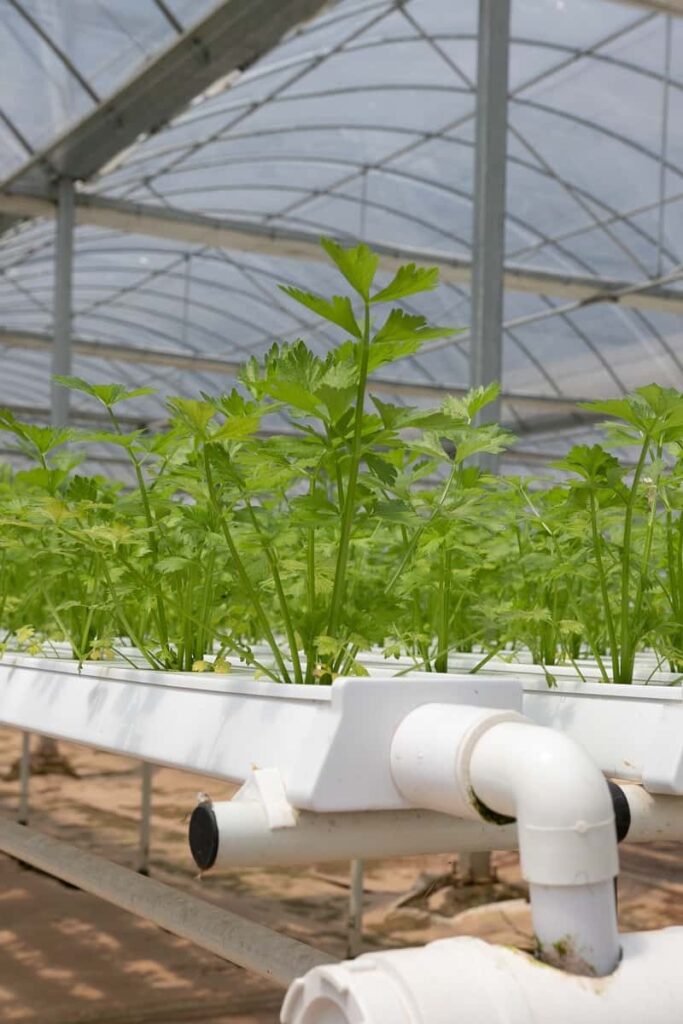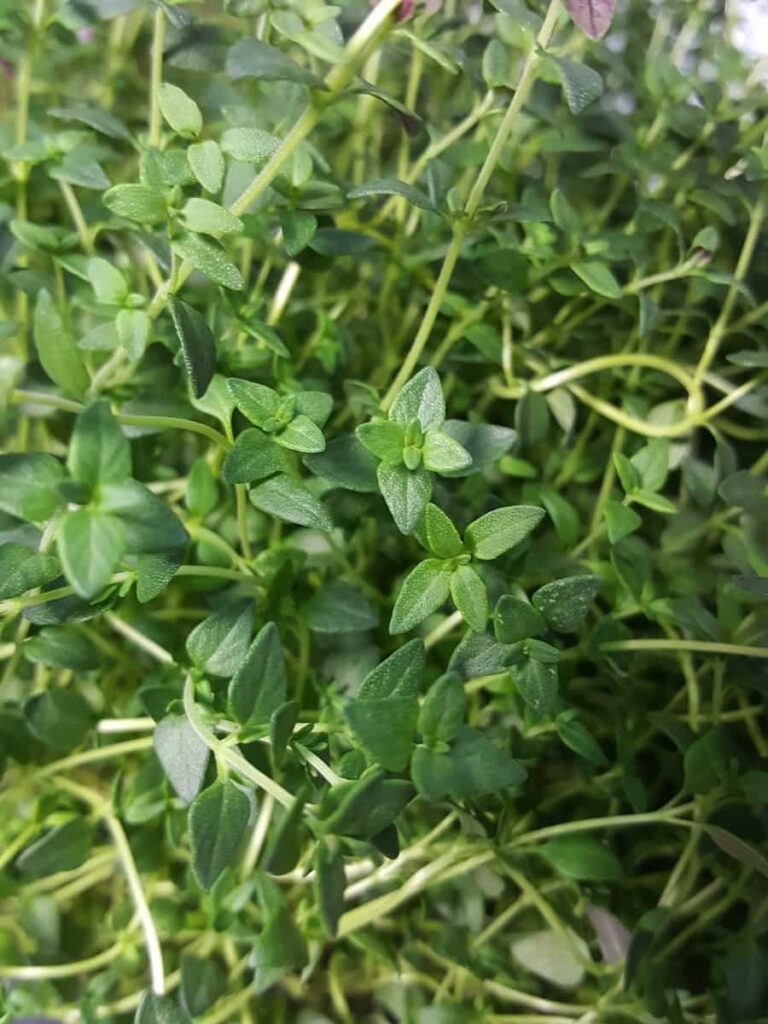Aquaponics is a method of growing plants in water recirculated from a fish tank. The fish waste provides nutrients for the plants, and the plants help filter the fish’s water. It’s a symbiotic relationship that can benefit both the plants and the fish. If you’re interested in growing aquaponics herbs, you should know a few things.
How to grow herbs in aquaponics
Best aquaponics system for growing herbs for beginners
If you’re looking to get started in aquaponics and want to grow herbs, there are a few things you’ll need to consider. In this article, we’ll go over the best aquaponics system for growing herbs for beginners.
- Firstly, you’ll need to decide what aquaponics system you want to use. There are two main types: media-based and raft-based. Media-based systems use a grow bed filled with gravel or other media for the plants to root in. Raft-based systems have a floating platform that the plants grow on.
- Each type of system has advantages and disadvantages, so choosing the right one is essential. For example, media-based systems are cheaper and easier to set up but can be more difficult to maintain. On the other hand, raft-based systems are more expensive but easier to maintain and offer a higher yield.
- Once you’ve chosen your system, you’ll need to select the right plants. Herbs are a great option for aquaponics because they don’t require a lot of space or care. Some herbs that do well in aquaponics include Basil, mint, oregano, and thyme.
- Once your system is set up and your plants selected, it’s time to start growing. Be sure to follow the instructions with your system carefully so your plants will thrive.
How to create an aquaponic herb garden?
Aquaponics is a type of gardening that uses fish waste to provide plant nutrients. Not only is it a great process to garden without using chemicals, but it’s also very efficient. Here’s how to get started:
- Choose a location for your garden. Aquaponic gardens can be set up indoors or outdoors. If people are in a cold climate, set your garden indoors, so the fish don’t freeze.
- Set up your grow bed. This is where your plants will grow. You can buy a ready-made grow bed or make your own out of PVC pipe or another material.
- Fill your grow bed with gravel or another type of media. This will provide support for the roots of your plants.
- Add water and fish to your system. The water should be filtered and free of chlorine. You can use goldfish, tilapia, or catfish in your aquaponic garden.
- Wait for the plants to grow. Once they start producing, you can begin harvesting your fresh herbs.
Best herbs to grow in aquaponics
- Aquaponics can grow almost any plant species. However, the popular plant choices for medicinal herb plants grown in aquaponics are Basil, watercress coriander, sage, thyme, oregano, lemongrass, parsley, chives, mint, chamomile, rosemary, and more. These herbs are all relatively easy to grow and thrive in an aquaponic system.
- Mint is a refreshing herb that can be used in many dishes. It grows well in aquaponics and does not require much maintenance.
- Basil is another versatile herb that can be used in many different recipes. It grows best in warm weather and does not like to be too wet.
- Oregano is a flavorful herb that is used in Italian cuisine. However, it prefers a drier environment and can be susceptible to root rot if the roots are too wet.
- Thyme is a fragrant herb that is often used in Mediterranean dishes. It grows well in most climates and does not require much care.
- Chives are another fast-growing herb that does well in an aquaponics system. They prefer cool temperatures and lots of sunlight. Chives will also need to be fertilized regularly to ensure they grow well.
- Cilantro is a slower-growing herb than Basil or chives, but it can still do well in aquaponics. It prefers cool temperatures and partial shade. Cilantro does not need to be fertilized as often as other herbs, but it may benefit from an occasional fish emulsion or compost tea doses.
- Sage is a savory herb that pairs well with many different foods. It can tolerate cooler temperatures and does not mind being on the dry side.
In case you missed it: Top 19 Steps to Boost Green Gram Yield: How to Increase Production, Mung Bean Quality, and Tips
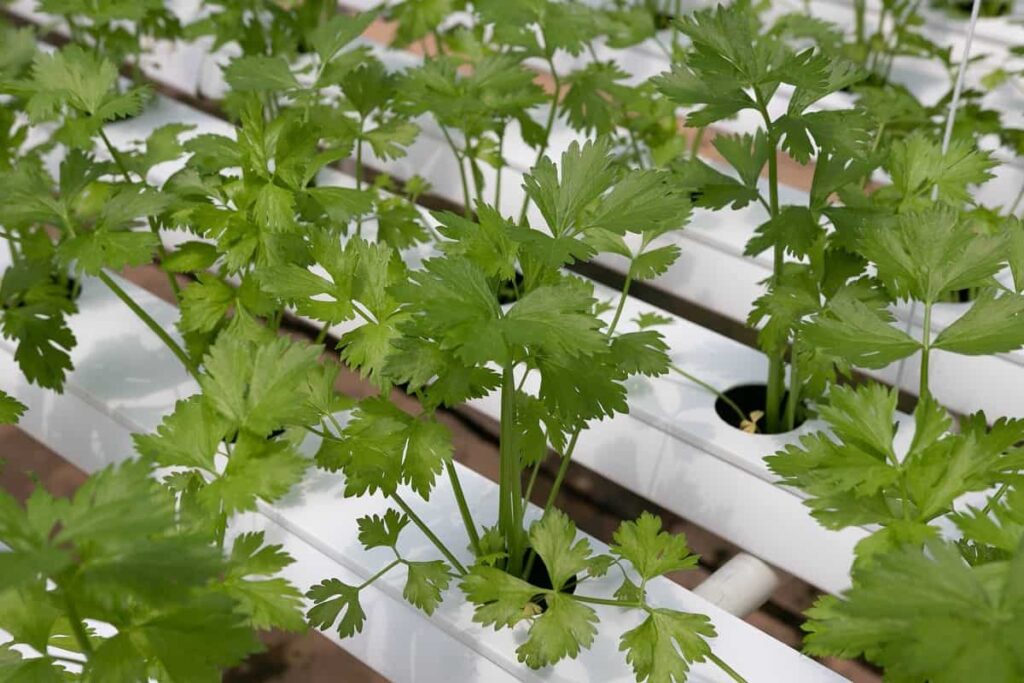
Best fish for aquaponic herb garden
Once your aquaponic system has been set up, deciding what type of fish species you want to grow is another main consideration you have to make. If you want to harvest fish species for food, tilapia, trout, catfish, and bass are great fish species for aquaponics. Your main choice for decorative fish is goldfish and koi. Your location, temperature, local laws, and fish availability will influence your choice of aquaponics fish.
Many different types of fish can be used in an aquaponic herb garden, but some are better than others. Goldfish, for example, is a popular choice because they are easy to care for and produce a lot of waste. However, goldfish also tend to eat plants, so goldfish may not be the best choice for an herb garden.
In case you missed it: Fish Farming Loan in India – How to Get/Apply, Banks, Interest Rate, Documents, and NABARD
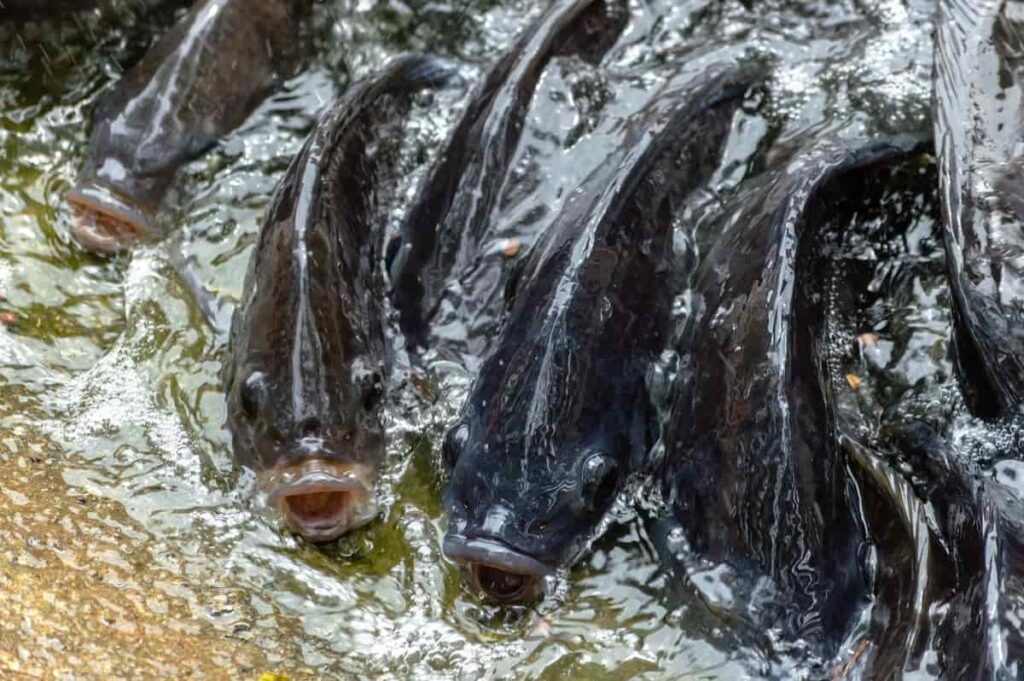
Other good options for fish include tilapia, catfish, and perch. These fish are less likely to eat plants and tolerate a wide range of water conditions. You’ll need to research which type of fish is best for your particular setup, but these three options are suitable for an aquaponic herb garden.
Considerations for growing herbs in aquaponics
- Before you start growing herbs in your aquaponics system, there are a few things to consider. There are many different kinds of herbs, and each has specific needs in terms of temperature, light, and nutrient requirements. Make sure you choose plants that will grow well in the conditions you can provide.
- Second, think about what you want to use the herbs for. If you plan on using them for cooking, you’ll want to ensure enough space to grow a good quantity. On the other hand, you won’t need as much space to grow a few plants for decoration or add flavor to your aquaponics fish tank.
- Third, consider what other plants you’re growing in your system. Some plants do not do well when grown together, so it’s important to research which plants are compatible before adding them to your aquaponics setup.
- Finally, remember that herbs can be finicky plants. They may not always do well in aquaponics systems, so don’t be discouraged if your first attempt is unsuccessful. Keep trying and adjusting your system until you find a combination that works for you.
Advantages of growing herbs in aquaponics
Aquaponics herb systems have many advantages over traditional methods of growing herbs. For one, they use far less water than soil-based methods. They also don’t require pesticides or other chemicals, as the plants are grown in a sterile environment. There are many advantages to growing herbs in aquaponics.
- One of the main advantages is that you can grow many herbs in a small space.
- Aquaponics is also a very efficient way to grow herbs since the water and nutrients are recirculated and used repeatedly. This means that you use less water and fewer resources overall.
- Another big advantage of growing herbs in aquaponics is that you can control the environment very well. Since the system is closed, you can easily control the temperature, humidity, and light levels.
- Growing herb plants using aquaponics helps you keep yielding herbs all year round.
- It takes up less space and reduces water use.
- It can eliminate soil-borne diseases in your herbs.
- Aquaponics eliminates pesticides and fertilizers, so your herbs are organic.
- Aquaponics uses less water than other methods of growing plants.
- Additionally, aquaponics herb systems can be used to grow various herbs. Finally, aquaponics systems can be used outdoors or indoors, which is the best option for herb growers.
In case you missed it: 16 Key Rules for Effective Greenhouse Farm Management: From Planning to Reducing Production Cost
Steps to grow herbs with a miniature aquaponics system
This type of system is perfect for herbs because they do not require a lot of space or nutrients to thrive. A miniature aquaponics system can be set up easily and does not take up much room. To grow herbs in an aquaponics system, you need the following:
- A fish tank
- A grow bed (this can be made out of a variety of materials such as PVC pipes or barrels)
- Herbs seeds or starts
- Water pump
- Grow lights (if growing indoors)
Setting up your system is relatively simple. Firstly, fill your fish tank with fresh water and add your fish. The number and type of fish you add will depend on the size of your system. Smaller systems can support about 5-10 fish. Once your fish are in the tank, add grow bed on top of the tank. If you use PVC pipes, cut them to size and connect them with fittings.
If you use a barrel, drill holes around the top edge for drainage. Fill the grow bed with gravel or hydroton balls and plant your herbs seeds or starts. Be sure to leave enough space between plants for proper growth. Add your water pump to the system and connect it to your grow bed. The pump will circulate water from the fish tank through the grow bed and back again.
Tips on growing herbs in aquaponics
- Start with small plants or seeds – Herbs can be grown from seed, but it is often easier to start with small plants.
- Choose the right location – Choose a location with plenty of sun.
- Use a nutrient-rich media – Herbs need nutrients to flourish, so make sure you use a media-rich in nutrients. One option is to use an organic fertilizer like fish emulsion or compost tea.
- Give them room to grow – Don’t overcrowd your herbs; give plants enough room to spread out and grow.
- Harvest regularly – Regular harvesting will encourage your herbs to keep growing new leaves.
In case you missed it: Seed Sowing and Harvesting Chart for Vegetables in the USA
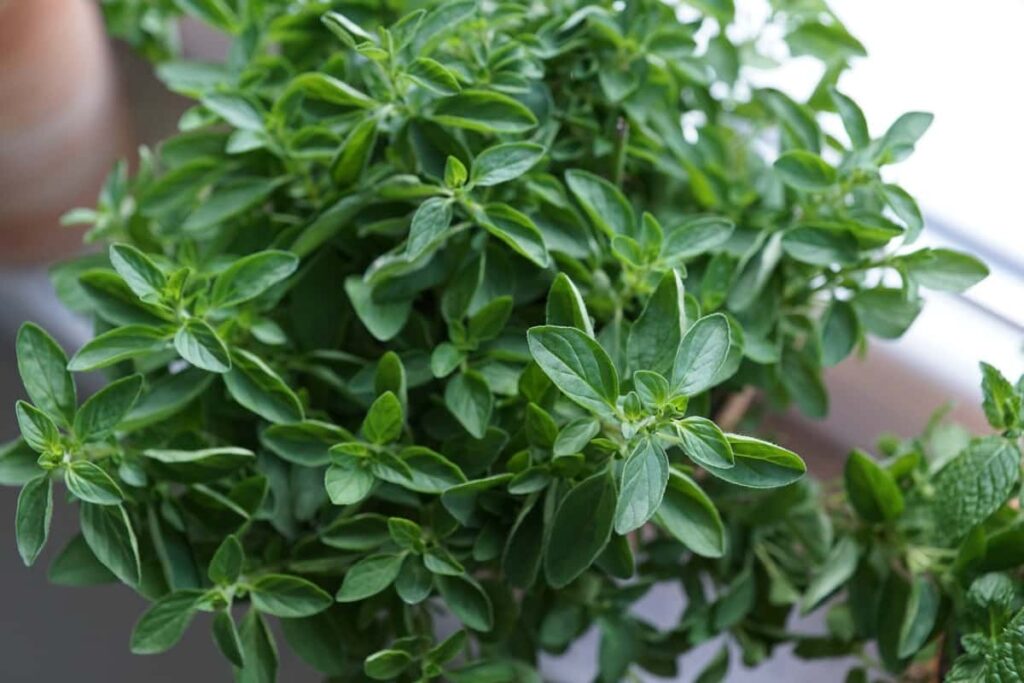
Best conditions for growing herbs in aquaponics
- Herbs are the easiest plants to grow in aquaponics. They are fast-growing, resilient, and easy to care for. With a little attention, you can have a thriving herb garden that provides fresh herbs all year round.
- Firstly, they need lots of light. Herbs love sunshine, so they will do well if you provide them with plenty of bright light. Second, they need good drainage. Third, they need consistent moisture. Water your herbs regularly so that the soil stays moist but not soggy.
- Herbs also benefit from regular fertilization. You can add compost or fish emulsion to your water once a month to boost them. Trim back regularly to keep them from taking over your entire system.
Necessary elements for growing herbs in aquaponics
- Aquaponic system: You can purchase an aquaponic system or build your using materials like PVC pipe, Styrofoam, and aquariums.
- Water: Your system will need to be filled with fresh water. You can use tap water, but it must be treated with a dechlorinating agent to remove chlorine and other chemicals.
- Fish: Aquaponic systems rely on fish waste to provide plant nutrients. You will need to choose a type of fish compatible with your climate and setup. Common choices include tilapia, catfish, and perch.
- Plants: Herbs are a great choice for aquaponics since they don’t require a lot of space or nutrients. Some popular herbs to grow to include Basil, mint, oregano, and thyme.
Keeping a successful aquaponics herbs garden
Assuming you would like a list of tips for keeping a successful aquaponics herbs garden:
- Start with a small, manageable system. You can always expand later if things are going well.
- Make sure your fish are healthy and happy. If they’re not, your plants won’t be either.
- Keep an eye on your water quality and ensure it’s within the ideal range for your plants and fish.
- Be patient. Everything can take a little while to get established and work together perfectly.
In case you missed it: Top 19 Steps/Ways/Methods to Boost Mint Yield: How to Increase Production and Quality
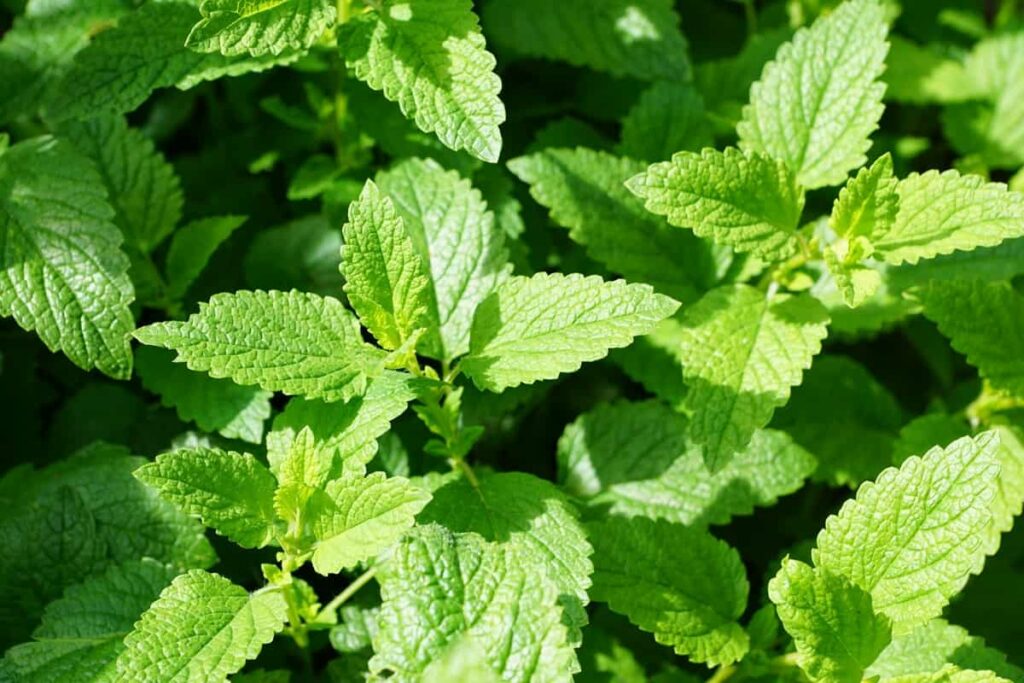
Maintaining your aquaponics herb system
- Aquaponics is a great process to grow herbs indoors year-round, but you need to make some important points to keep your system running smoothly. Firstly, you must ensure that your fish tank is properly aerated. This will keep the water oxygenated and the fish healthy. You can do this with an air stone and an air pump.
- Next, you need to check the pH of the water regularly. The ideal pH for most plants is between 6.0 and 7.5. You can test the pH level with test strips or a digital pH meter. If the pH is too low, you can add some baking soda to raise it. You can add some vinegar or lemon juice to lower it if it’s too high.
- Third, you need to fertilize your plants regularly. You can use liquid fish fertilizer or compost tea as an organic option. Fourth, you should check your plants for pests and diseases and treat them accordingly.
- Finally, remember to clean your system regularly. This includes scrubbing the grow beds and filters and doing partial water changes every few weeks.
Commonly asked questions about growing herbs in aquaponics (FAQ)
Can you grow herbs in a fish tank?
Growing herbs in a fish tank work well because the aquarium lets in light and moistens the soil.
In case you missed it: Organic Coriander Farming – Planting Guide
Can you grow mint in aquaponics?
Mint is an excellent plant for aquaponics systems; however, care ought to be used to avoid immoderate nutrient depletion of the water.
Can you grow cilantro in aquaponics?
A guide to growing coriander in aquaponics (Cilantro/Dhaniya) Coriander plants give more yield to have higher nutritional requirements, and they grow well in aquaponics systems.
Why is mint good for aquaponics?
It is suitable for aquaponics systems because the flavor of herbs like mint is stronger due to the clean water and controlled hygienic conditions in an aquaponics system compared to those planted in soil.
Conclusion
Aquaponic herb garden uses fish waste to provide plant nutrients. The plants are grown in a media bed, and the water from the fish tank is pumped through the media bed to provide nutrients for the plants. It is a great way to grow herbs because it uses very little water, and the plants get all the nutrients they need from fish waste.
- Goat Farming Training Programs in India: A Beginner’s Guide
- Types of Pesticides Used in Agriculture: A Beginner’s Guide
- Economical Aquaculture: A Guide to Low-Budget Fish Farming
- 15 Common Planting Errors That Can Doom Your Fruit Trees
- How to Make Houseplants Bushy: Effective Tips and Ideas
- Innovative Strategies for Boosting Coconut Pollination and Yield
- Pollination Strategies for Maximum Pumpkin Yield
- The Complete Guide to Chicken Fattening: Strategies for Maximum Growth
- Natural Solutions for Tulip Problems: 100% Effective Remedies for Leaf and Bulb-Related Issues
- Revolutionizing Citrus Preservation: Towards a Healthier, Greener Future
- Natural Solutions for Peony Leaf and Flower Problems: 100% Effective Remedies
- Maximizing Profits with Avocado Contract Farming in India: A Comprehensive Guide
- Natural Solutions for Hydrangea Problems: 100% Effective Remedies for Leaf and Flowers
- The Ultimate Guide to Choosing the Perfect Foliage Friend: Bringing Life Indoors
- From Sunlight to Sustainability: 15 Ways to Use Solar Technology in Agriculture
- The Ultimate Guide to Dong Tao Chicken: Exploring from History to Raising
- The Eco-Friendly Makeover: How to Convert Your Unused Swimming Pool into a Fish Pond
- Mastering the Art of Delaware Chicken Farming: Essentials for Healthy Backyard Flocks
- 20 Best Homemade Fertilizers for Money Plant: DIY Recipes and Application Methods
- How to Craft a Comprehensive Free-Range Chicken Farming Business Plan
- Brighten Your Flock: Raising Easter Egger Chickens for Beauty and Bounty
- How to Optimize Your Poultry Egg Farm Business Plan with These Strategies
- Subsidy for Spirulina Cultivation: How Indian Government Schemes Encouraging Spirulina Farmers
- Ultimate Guide to Raising Dominique Chickens: Breeding, Feeding, Egg-Production, and Care
- Mastering the Art of Raising Jersey Giant Chickens: Care, Feeding, and More
- Ultimate Guide to Raising Legbar Chickens: Breeding, Farming Practices, Diet, Egg-Production
- How to Raise Welsummer Chickens: A Comprehensive Guide for Beginners
- How to Protect Indoor Plants in Winter: A Comprehensive Guide
- Ultimate Guide to Grow Bag Gardening: Tips, Tricks, and Planting Ideas for Urban Gardeners
- Guide to Lotus Cultivation: How to Propagate, Plant, Grow, Care, Cost, and Profit
- Agriculture Drone Subsidy Scheme: Government Kisan Subsidy, License, and How to Apply Online
- Ultimate Guide to Raising Araucana Chickens: Breed Profile, Farming Economics, Diet, and Care
- Bringing Hydroponics to Classroom: Importance, Benefits of Learning for School Students
- Ultimate Guide to Raising Polish Chickens: Breed Profile, Farming Economics, Diet, and Care
- Ultimate Guide to Raising Australorp Chickens: Profile, Farming Economics, Egg Production, Diet, and Care
- Silkie Chicken Farming: Raising Practices, Varieties, Egg Production, Diet, and Care
